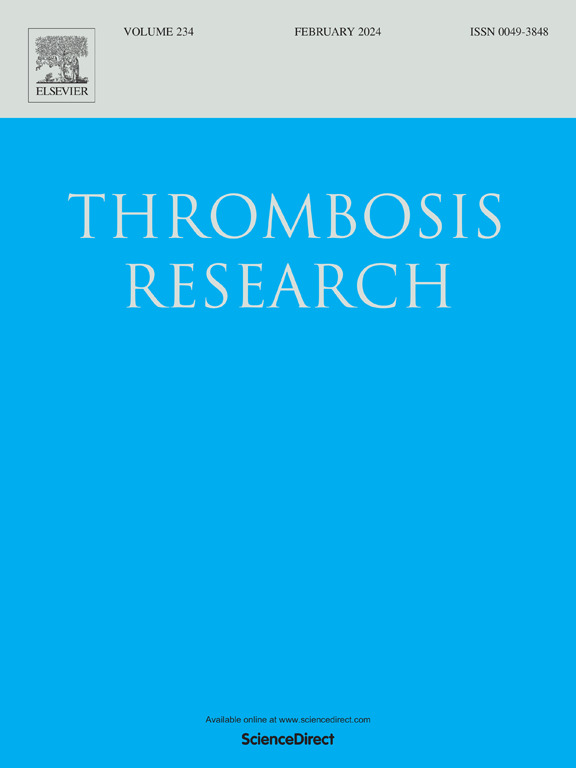犹他大学健康中心成年肥胖症患者静脉血栓栓塞症的直接口服抗凝剂处方趋势。
IF 3.7
3区 医学
Q1 HEMATOLOGY
引用次数: 0
摘要
背景:抗凝剂,包括华法林和直接口服抗凝剂(DOACs),用于预防和治疗肥胖患者常见的静脉血栓栓塞症(VTE)。有关在此类患者中使用 DOACs 治疗 VTE 的指导声明已经更新:研究肥胖和 VTE 患者的 DOAC 处方趋势:我们对2014年至2022年期间肥胖(体重指数≥30)且客观确诊为VTE的成年患者的DOAC处方趋势进行了一项回顾性、单站点跨序列研究。研究的主要结果是开具 DOAC 的肥胖患者比例:共有 1826 名患者纳入我们的分析。大多数患者为白种人(85.8%),约半数为女性。肺栓塞是最常见的 VTE 类型(62.2%)。共有 1018 名患者接受了 DOAC 治疗(55.8%),524 名患者接受了华法林治疗(28.7%),284 名患者接受了依诺肝素治疗(15.6%)。逻辑回归分析显示,从2017年到2022年,DOAC的使用率呈显著上升趋势(与2014年相比,几率比[OR]为1.85至14.08),但从2015年到2016年,这一趋势并不明显(OR为1.30至1.52)。BMI≥40和≥50的患者获得华法林处方的可能性分别是DOAC的2倍和4倍:2017年至2022年间,为治疗VTE而处方DOACs的肥胖患者比例显著增加。这表明,尽管缺乏随机对照试验的安全性和有效性数据,但除体重非常大的患者外,在这一患者群体中处方 DOACs 的可能性越来越大。本文章由计算机程序翻译,如有差异,请以英文原文为准。
Direct oral anticoagulant prescribing trends for venous thromboembolism among adult patients with obesity at University of Utah Health
Background
Anticoagulants, including warfarin and direct oral anticoagulants (DOACs), are used to prevent and treat venous thromboembolism (VTE) which is common in patients with obesity. Guidance statements regarding use of DOACs for VTE treatment in this patient population have been updated.
Objective
Examine DOAC prescribing trends in patients with obesity and VTE.
Methods
We performed a retrospective, single-site cross-sequential study of DOAC prescribing trends in adult patients with obesity (BMI ≥30) and objectively confirmed VTE diagnosis between 2014 and 2022. The primary outcome of interest was the proportion of patients with obesity prescribed DOACs.
Results
A total of 1826 patients were included in our analysis. Most patients were of White race (85.8 %) and approximately half were female. Pulmonary embolism was the most common VTE type (62.2 %). A total of 1018 patients were prescribed DOAC therapy (55.8 %), 524 warfarin therapy (28.7 %), and 284 enoxaparin (15.6 %). Logistic regression analysis revealed that the utilization of DOACs exhibited a significant upward trend from 2017 to 2022 (odds ratio [OR] 1.85 to 14.08 compared to 2014), but not from 2015 to 2016 (OR 1.30 to 1.52). Patients with BMI ≥ 40 and ≥ 50 were twice and 4-times as likely to be prescribed warfarin than DOACs, respectively.
Conclusion
Between 2017 and 2022, the proportion of patients with obesity prescribed DOACs for the treatment of VTE increased significantly. This suggests an increasing likelihood to prescribe DOACs in this patient population despite the lack of safety and efficacy data from randomized controlled trials except for very heavy patients.
求助全文
通过发布文献求助,成功后即可免费获取论文全文。
去求助
来源期刊

Thrombosis research
医学-外周血管病
CiteScore
14.60
自引率
4.00%
发文量
364
审稿时长
31 days
期刊介绍:
Thrombosis Research is an international journal dedicated to the swift dissemination of new information on thrombosis, hemostasis, and vascular biology, aimed at advancing both science and clinical care. The journal publishes peer-reviewed original research, reviews, editorials, opinions, and critiques, covering both basic and clinical studies. Priority is given to research that promises novel approaches in the diagnosis, therapy, prognosis, and prevention of thrombotic and hemorrhagic diseases.
 求助内容:
求助内容: 应助结果提醒方式:
应助结果提醒方式:


